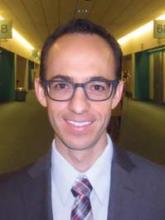SAN DIEGO – High-dose prednisolone appears to be an effective alternative to adrenocorticotropic hormone for infantile spasms, according to a small prospective study from the University of California, Los Angeles.
Sixty percent of infants (18 of 30) with the potentially devastating childhood epilepsy for a median of 4.5 months were cured following 2 weeks of high-dose oral prednisolone, 8 mg/kg per day. Five of the 12 (42%) who failed prednisolone were cured with a subsequent 2 weeks of intramuscular adrenocorticotropic hormone (ACTH), 150 IU/m2 per day.
Lead investigator and neurologist Dr. Shaun Hussain, a UCLA clinical assistant professor of pediatrics, said he did the study because "there’s no agreement about which agent is best and which dosage is best." Previous studies have shown superiority for ACTH, but only against doses of prednisolone lower than 2 mg/kg per day; more recent work suggests high-dose prednisolone works as well as ACTH (Epilepsy Behav. 2009;14:674-6).
ACTH is also far more expensive than prednisolone, about $125,000 per treatment course instead of $200.
A large multicenter randomized comparison trial is needed to settle the debate; Dr. Hussain said he hopes to organize one. In the meantime, institutions like UCLA are leaning toward high-dose prednisolone, others lean toward ACTH, and some have abandoned ACTH altogether, he said.
For now, "I don’t think ACTH should be abandoned. I say that because five patients ended up responding to ACTH after they failed prednisolone. I believe instead of abandoning ACTH, it should simply be reserved for those patients who fail high-dose prednisolone," Dr. Hussain said at the annual meeting of the American Epilepsy Society.
Spasm onset in the 30 infants came at a median of 6.5 months, and study entry at a median of 11 months. Most of the children were boys, most were symptomatic, and most had an identifiable cause of the problem, including prenatal stroke and focal cortical dysplasia.
The children had failed prior treatments, contributing to the delay in trial entry. "We think in general [the delay] contributed to intractability," and that the cumulative response rate of "77% [23 of 30] is pretty good given our refractory population." Had the protocol been applied to a less-refractory group, it’s possible the results would have rivaled the 90% or so ACTH cure rates reported with more tractable patients, Dr. Hussain said.
That some patients who failed high-dose prednisolone responded to ACTH may mean that ACTH is better, or that prednisolone should have been continued a week or two longer, he noted.
Twenty patients (67%) had hypsarrhythmia at baseline, confirmed by overnight video EEGs. A second overnight video EEG assessed cure rates – a complete absence of spasms and hypsarrhythmia – following 2 weeks of prednisolone. The 12 infants who did not respond were immediately switched to ACTH.
Two of the 18 prednisolone responders (11%) relapsed within 5 months; one responded to additional high-dose prednisolone. Two of the five ACTH responders (40%) relapsed.
Dr. Hussain is an adviser to Questcor, the maker of ACTH (Acthar Gel), and has a research grant from Lundbeck.


